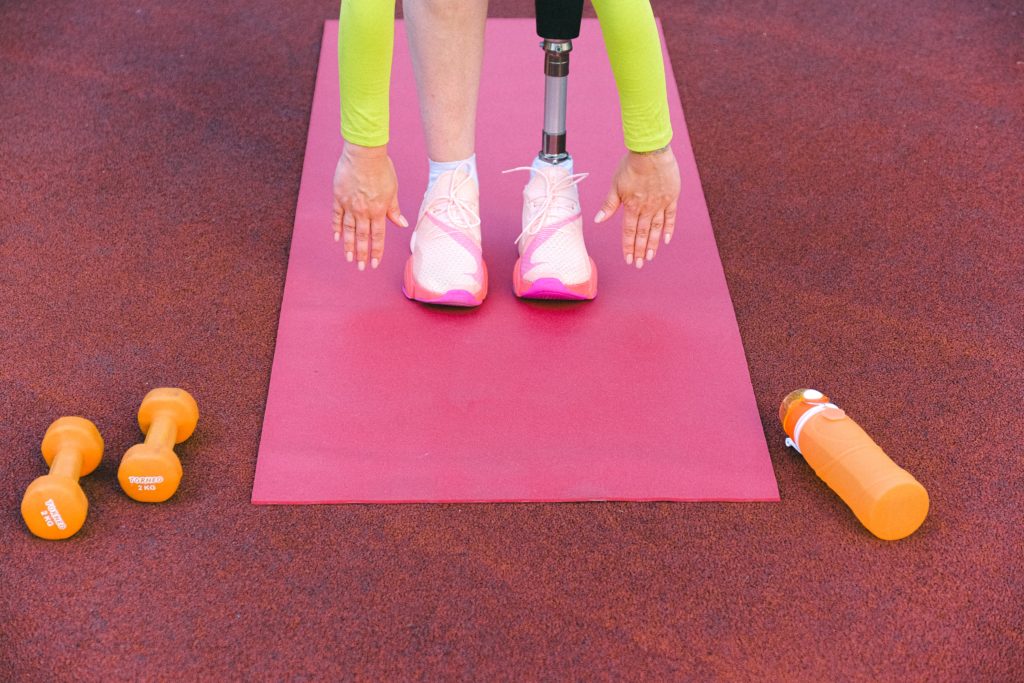
This blog post explores some of the themes in the Department for Communities draft strategy for sport and physical activity and compares plans for Northern Ireland (NI) with similar proposals for Great Britain (GB) and Ireland.
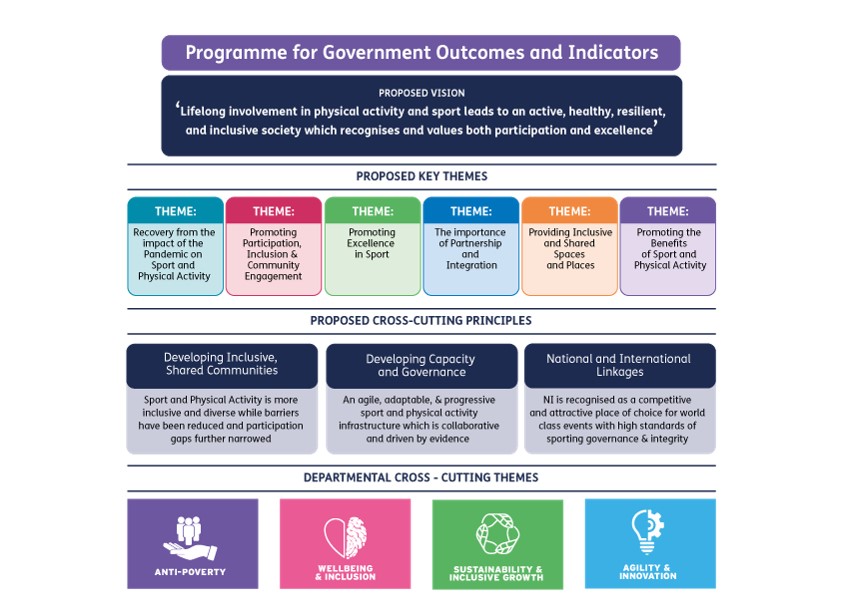
How active are we?
When it comes to sport and physical activity in Northern Ireland, while our elite sports people are gaining international success, the rest of us are falling to the bottom of the physical activity league tables. According to sport and physical activity participation rates for 2019/20, the majority of females, children and people with disabilities in NI are not meeting the Chief Medical Officers’ guidelines for physical activity. Before COVID-19, we were doing better than a decade ago but we could improve, and our future health depends on it.
The Department for Communities (DfC) is currently drafting a new sports and physical activity strategy, setting out how it plans to support improvements in this situation, over the next ten years. In developing their proposals, DfC officials have gathered feedback from over 350 stakeholders and the consultation process closed on 14 May 2021.
So, what’s new?
First and foremost, the strategy acknowledges the work needed to safely recover participation rates to pre-COVID-19 levels. The three aims within this first of six themes address the internationally available evidence from the United Nations (UN). These include that the pandemic has particularly impacted older people, people with disabilities and families living in areas of high deprivation participating in sport and physical activity.
Community spirit
A positive story highlighted at a recent information session about the new strategy was the quick response of local sports clubs in the first lockdown to support the most vulnerable parts of their communities. As well as recovering people’s confidence to be physically active, the plan aims to sustain and build on the sense of community spirit and cohesion experienced during the pandemic.
More joined-up thinking
The importance of shared spaces and inclusive partnerships is mentioned in several of the six themes in the strategy. As well as suggesting that sports venues and facilities should be ‘shared’ and ‘inclusive’, this also refers to a cross-departmental approach to working.
Lifetime participation
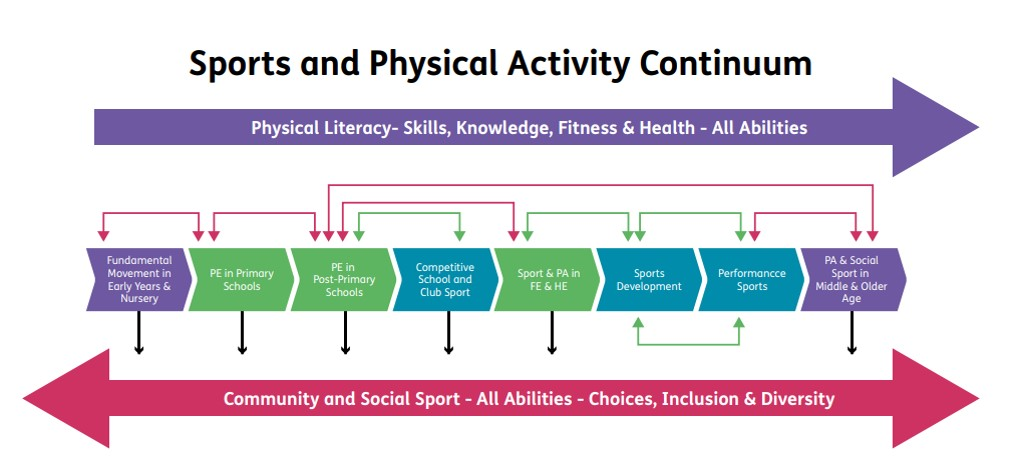
In order to support more people to be more active, more of the time, officials outlined the sports ‘ecosystem’ and recognised that this plan should link to aims across the Executive, with initiatives that include people at all stages of their lives. DfC has formed a project board with members from each of the government departments. Also, the cross-cutting nature of this strategy is captured in the proposals for a new Programme for Government, where sport is mentioned in several different outcomes and priorities.
The sports and physical activity ecosystem in NI
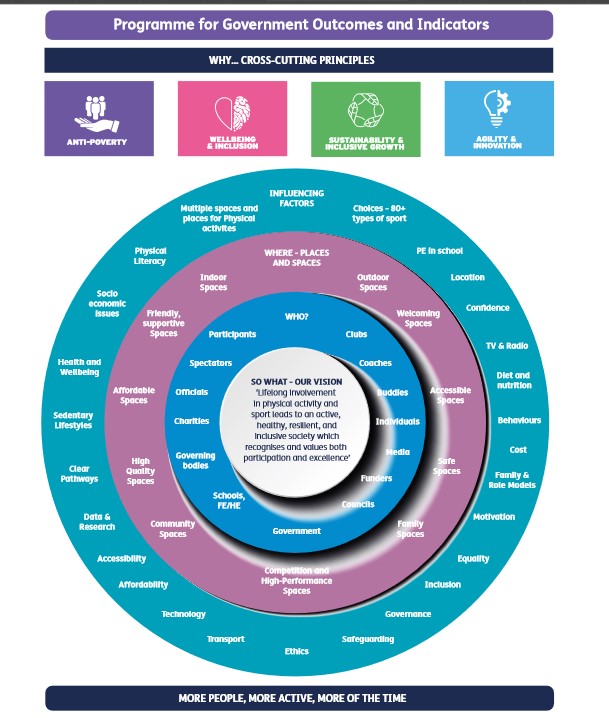
A key example of the cross-cutting nature of themes in this strategy is highlighted in recent research for the Assembly’s Education Committee:
Children’s emotional health, physical fitness and obesity levels are resultant of a complex range of individual, family and community level factors which schools alone cannot solve. (…) For many children, school is the main opportunity they have for being physically active, either through PE or after-school activities.
In taking the sports strategy forward, there will be a strong emphasis on co-designing new initiatives ‘with’ communities, rather than ‘for’ them. DfC officials described plans to offer a broader spectrum of sports such as hip-hop dance to children, particularly teenage girls, if that’s what they want. Research has shown that the transition from primary to post-primary education is a key moment in determining a female’s future participation in sport and physical activity. Also, post-primary physical education in schools still tends to be games focused, which can be off-putting for those more interested in less competitive activities.
Another goal is to increase awareness of the benefits of physical activity. This also reflects findings in the research, where if people know the guidance is to participate in at least 150 minutes of physical activity per week, they’re more likely to attempt it. Also, the use of emerging and innovative technologies is a goal, although officials acknowledged this had the potential to create a barrier to participation due to the digital divide that the COVID-19 pandemic has also highlighted.
How do our sporting goals compare with jurisdictions elsewhere?
The Department for Communities draft sport and physical activity strategy differs from similar plans in England, Scotland, Wales and Ireland by directly addressing the recovery from the impact of the pandemic. This is due to the timing of its publication, a year after the COVID-19 pandemic began. Also, similar to England, the strategy in Northern Ireland addresses elite as well as grassroots sport and physical activity. In Ireland, Wales and Scotland, there are separate plans for physical activity and sport, with specific goals to increase children’s participation. As the comparison of goals included in Table 1 demonstrates, the cross-cutting benefits of sport to our health, education and environment relate to six of the 17 United Nations Sustainable Development Goals.
Table 1: A comparison of sport and physical activity goals
| Jurisdiction | Goals |
| UN Sustainable Development Goals (2015) | Goal 3: Ensure healthy lives and promote well-being for all at all ages
Goal 4: Ensure inclusive and quality education for all and promote lifelong learning Goal 5: Achieve gender equality and empower all women and girls Goal 11: Make cities inclusive, safe, resilient and sustainable Goal 16: Promote just, peaceful and inclusive societies Goal 17: Revitalise the global partnership for sustainable development |
| Northern Ireland (2021) | Recovery from the impact of the pandemic on sport and physical activity
Promoting participation, inclusion & community engagement Promoting excellence in sport The importance of partnership and integration Providing inclusion and shared spaces and places Promoting the benefits of sport and physical activity |
| Wales (2019)
Physical Activity Plan |
Physical activity opportunities are accessible to all
Being active is the norm Activity is at the centre of the school ethos and physical literacy is as important as numeracy and language All children play frequently outdoors in safe environments The majority of children and adults regularly use leisure facilities and sports clubs People use their local environment for active recreation Active travel is the first choice for short distances for both children and adults Individuals are never too old to be active |
| Scotland (2018)
Physical Activity Plan |
To cut physical inactivity by 15% across Scotland by 2030, in line with the WHO’s Global Action Plan for Physical Activity.
We encourage and enable the inactive to be more active We encourage and enable the active to stay active throughout life We develop physical confidence and competence from the earliest age We improve our active infrastructure – people and places We support wellbeing and resilience in communities through physical activity and sport We improve opportunities to participate, progress and achieve in sport |
| England (2015)
Sport and Physical Activity Plan |
More people from every background regularly and meaningfully:
a) taking part in sport and physical activity b) volunteering c) experiencing live sport Maximising international and domestic sporting success and the impact of major events Supporting a more productive, sustainable and responsible sport sector Measuring the Impact |
| Ireland (2019)
Physical Activity Plan |
Public Awareness, Education and Communication
Children and Young People Health Environment Workplaces Sport and Physical Activity in the Community Research, Monitoring and Evaluation Implementation through Partnership |
How will we know we’ve made progress?
Following a Research and Information Service (RaISe) briefing on sports participation levels in NI for the Assembly’s Committee for Communities on 27 May 2021, Members questioned how the draft strategy’s progress will be monitored. DfC is yet to publish plans on this detail. The different approaches used in GB and Ireland are perhaps useful to consider.
Sport England
The UK Government Department for Digital, Culture, Media and Sport (DCMS) published its ‘Sporting Future: A New Strategy for an Active Nation‘ in December 2015. One of the aims was to ‘move beyond merely looking at how many people take part’ and instead base funding decisions on the ‘…social good that sport and physical activity can deliver’. Two review exercises later, and the measurements related to sport and physical activity include ‘…ensuring that we harness the impact of sport and physical activity on both physical and mental health’. Mental health and community development impacts are captured annually by Sport England’s ‘Active Lives’ survey.
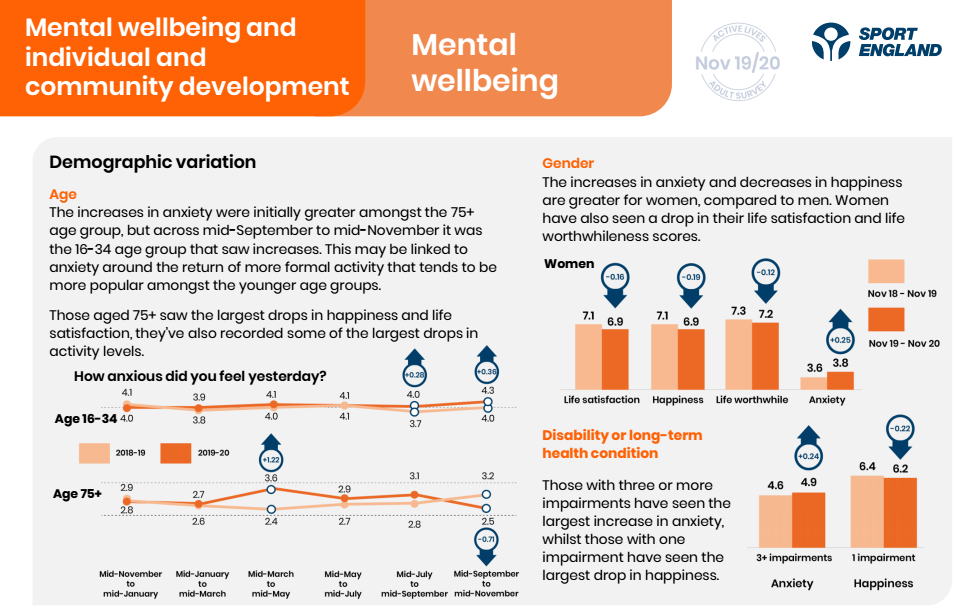
Sport Ireland
Ireland has two separate plans for sports and physical activity. The National Physical Activity Plan stems from the Healthy Ireland framework for improved health and well-being. This plan aimed to move beyond telling people to do more physical activity because it is good for them, and instead:
- Create increased opportunities for people to be active in ways which fit in to everyday lives and which suits individual needs, circumstances and interests;
- Remove the barriers which people face to being active and encourage people to recognise how to overcome those barriers;
- Enhance cross-sectoral cooperation at national, local and community level to encourage physical activity at every level;
- Encourage a supportive environment where physical activity becomes normal; and
- Promote good practice and find new models of participation which get more people active.
As well as recording the levels of participation, the annual progress reports monitor the size of the gap or gradient between the participation levels of eg males and females. Resulting support initiatives are monitored in relation to these targets.
Sport Northern Ireland
Between 2011 and 2019 in Northern Ireland, female participation rates increased. However, as the line graph illustrates, the gap between levels of male and female participation, remained fairly static during that time.
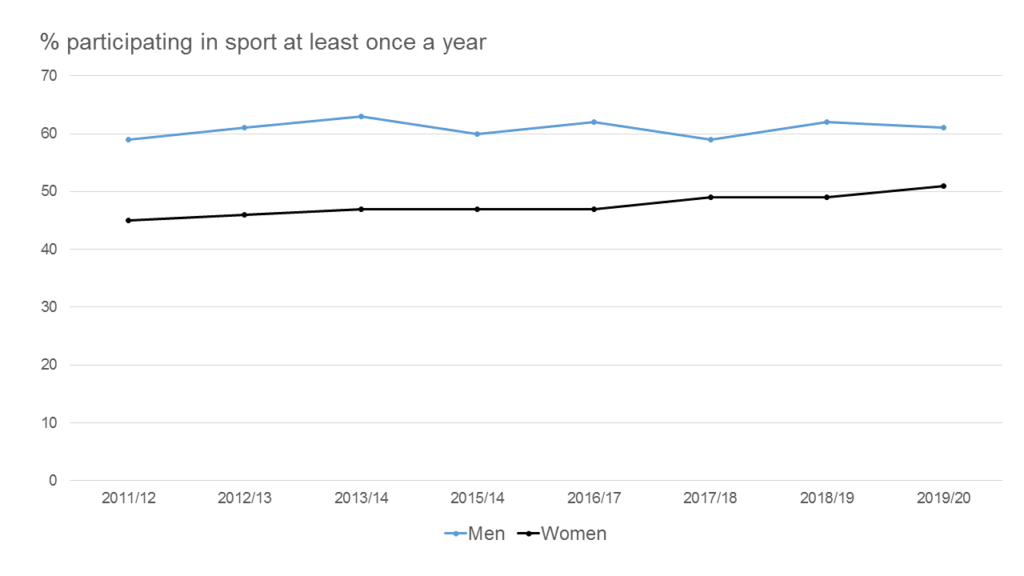
Sport NI has recently published its draft 2020-2025 Corporate Plan, with aims of supporting more people to get active and make athletes from NI the best in the world. In terms of its plans for measuring success, as well as monitoring participation rates, similar to Sport England’s ‘Active Lives’ survey methodology, Sport NI has proposed it will;
…look for the ‘story behind the headline’, with a particular emphasis on what the data tells us about the experience of those groups of people who have traditionally been excluded from, or under-represented in, sport and physical recreation.
A More Active Scotland
The vision for Scotland’s physical activity plan, mirrors Northern Ireland’s:
Our vision is of a Scotland where more people are more active, more often.
The More Active Scotland Delivery Plan was published in 2018. It is focused on physical activity, using the World Health Organisation’s definition;
…any bodily movement produced by skeletal muscles that requires energy expenditure. It thus includes activities such as everyday walking or cycling to get from A to B, active play, work related activity, active recreation such as working out in a gym, dancing, gardening or playing active games, as well as organised and competitive sport and many other activities.
DfC’s new plans for NI focus on physical activity for the first time. This is significant as when walking for recreation is included as a physical activity, the female participation rates increase by almost 25%.
Climbing Higher in Wales
Our Climbing Higher plan is helping children and adults get involved with sport, walk and exercise more, and stay well. By 2025, we want most people to be taking enough exercise to see significant health benefits.
The Welsh strategy for sport and physical activity was a twenty-year plan, first published in 2005 and last updated in 2015.
The purpose of this strategy, which complements other Welsh Assembly Government actions and policies, is that within 20 years’ sport and physical activity will be at the heart of Welsh life and at the heart of Government policy.
The priorities for sport and physical activity for Wales are identified as:
- Wales needs to be more physically active in order to be a healthier nation;
- Wales needs healthy citizens to deliver long-term prosperity;
- Wales needs to maximise the synergy between sport, physical activity and the natural environment;
- Wales needs its people to be more ‘physically literate’;
- Wales needs more physically active communities and
- As well as the success of individuals, Wales needs systematic and sustainable success in priority sports.
There are sixteen cross-cutting targets in the strategy that range from health to culture, international sporting success to the environment and the economy. In an update published in 2019, new initiatives included the provision of free swimming for children under 16 and adults over 60, as well as a £1 million fund for sports facilities and a £5 million ‘Healthy and Active’ fund in partnership with Sport Wales, Public Health Wales and the Welsh Government.
Next steps
The next steps in the process of delivering DfC’s new sports and physical activity strategy for NI will be the development of action plans, a new digital system for delivery data, as well as the establishment of monitoring and reporting structures.

